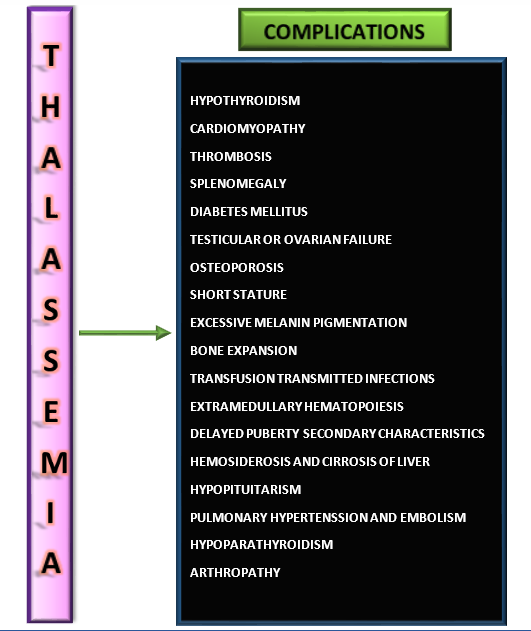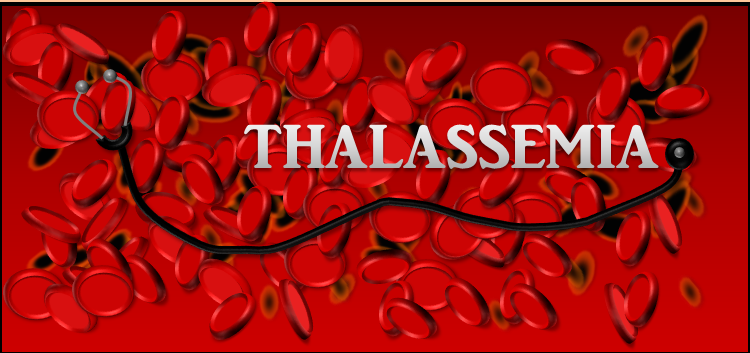One of the most common group of inherited genetic haemoglobin abnormalities leading to haematological disorders caused by the defects in the synthesis of haemoglobin chains. Lack of proper synthesis of globin chains results in impaired erythropoiesis and hemolysis. Based on the defects in the synthesis of different chains present in haemoglobin, thalassemia are of two types: 1) Alpha thalassemia 2) Beta thalassemia.

1) Alpha Thalassemia:
Alpha thalassemia is a condition caused by the defects in the synthesis or reduced abilities for the synthesis of the alpha globin chain. It has became one of the common clinical issue in North America, Europe and Australia and even in the regions where malaria was still an epidemic. Some Individuals are asymptomatic and requires no particular treatment as they may be silent carriers of alpha thalassemia. Hemolytic anemia is observed in individuals with alpha thalassemia intermedia or Hemoglobin H disease. Fatal hydrops fetalis syndrome is seen as a result of alpha thalassemia major with hemoglobin Bart’s which is lethal for fetus. It is caused by the different molecular defects, most frequently involving deletion of one or both alpha globin chains or less frequently by non-deletional defects.

The presence of single deletion (-alpha/alpha alpha) in the alpha globin chain result in the silent carrier state. In new-borns, it is characterized by the mild increase (1-2%) of Hb Bart, which is a tetramer of globin chains (gamma 4) results from the presence of excess gamma chains relative to alpha chains. Whereas the alpha/-alpha thalassemia trait is caused by the two gene deletions. In adults, one gene deletions can be in different states, as it may be in completely silent state or associated with hypochromia (red blood cells having less colour than normal because of iron deficiency) or moderate microcytosis (red blood cells smaller than normal) with normal HbA2. Alpha/-alpha is the moderate increase of Hb-Bart (5-6%) in new-borns and adults showing reduced alpha/beta globin chain synthesis ratio. The most severe condition of alpha thalassemia is Hb-bart hydrops fetalis syndrome. The syndrome affecting the foetus are usually stillborn or die soon after the birth. According to the reports, two distinct types of HbH disease, one which is associated with myelodysplasia and other is alpha thalassemia associated with mental retardation syndromes. Myelodysplasia is characterized by the presence of HbH inclusion bodies in RBCs with severe microcytic and hypochromic anaemia. Some of the patients shows point mutation and/or splicing abnormalities in the ATRX gene. The other type i.e the alpha thalassemia associated with mental retardation syndrome includes two different forms, one of the form is characterized by the delayed development, facial and skeletal abnormalities, and mild mental retardation which is known as ATR 16 syndrome resulted from extended deletions of the short arm of chromosome 16, thus removing both alpha genes and flanking other genes. The other form is characterized by genital abnormalities, wide mouth, flat nasal bridge, hypertelorism (increased distance between bodily parts, example: eyes), triangular upturned nose and severe mental retardation. This is a result of mutations in ATRX gene which encodes a chromatin associated proteins performing various functions in cellular processes such as DNA repair. Control of cell cycle, transcriptional regulation, mitotic chromosome segregation. The chromatin associated proteins belong to the SNF2 family of helicase/ adenosine triphosphatases.

2) Beta thalassemia:
Beta thalassemia is a condition of reduced or defects in the synthesis of beta globin chains. Beta thalassemia has various range of phenotype from asymptomatic to individuals showing severe anaemia. It is prevalent in the countries of India, Southern China, Africa, America. There are three main types of this condition, thalassemia minor, thalassemia intermedia, and thalassemia major. Individuals suffering from thalassemia major have seen with severe anaemia and usually requires red blood cell transfusion. The patients with untreated thalassemia major leads to hepatosplenomegaly, growth retardation, leg ulcers, jaundice, poor musculature, skeletal changes, and pallor (pale skin). Patients of thalassemia intermedia have moderate anaemia with clinical features such as medullary and extramedullary haematopoiesis, hypertrophy of erythroid marrow and related complications like bone deformities, osteoporosis, facial changes, gallstones, painful leg ulcers, thrombosis. Thalassemia minor patients are mostly asymptomatic but some of them may show moderate anaemia. Thalassemia major patients given regular transfusion therapy results in other complications leading to iron overload related problems, diabetes mellitus,failure of sexual maturation, growth retardation, liver fibrosis and cirrhosis, dilated myocardiopathy. Thalassemia intermedia patients doesn’t require regular transfusion therapy.
The point mutations and more rarely deletions in the beta globin chain gene on chromosome 11 are the cause for the beta thalassemia. Thus reduced synthesis of the beta chain or no synthesis occurs leading to beta thalassemia.
